Abstract
The differences reported by various authors in regard to the inhibitory effect of the same antimitotic product on the production of antibodies, may be attributable in particular to the antigen used and to the technique of administration of the product. These differences have made it necessary to work out a test that is not subject to criticism in these respects.
After an investigation of the cytological reactions provoked in the mouse by various antigens, the authors have singled out three of these antigens: human albumin, the poliomyelitis virus and an allogeneic skin graft. The hyperbasophilic cells which are predominantly present in the lymphoid centres are, respectively, lymphocytes for the first, plasmocytes for the second and histiocytes for the third of these antigens.
In view of the different mechanisms of action that are possible with the different antimitotic products the authors used three methods of administration: entirely `before' the antigenic stimulus; total dose administered entirely `after' the antigenic stimulus; total dose administered partially `before' and partially `after' the antigenic stimulus.
Full text
PDF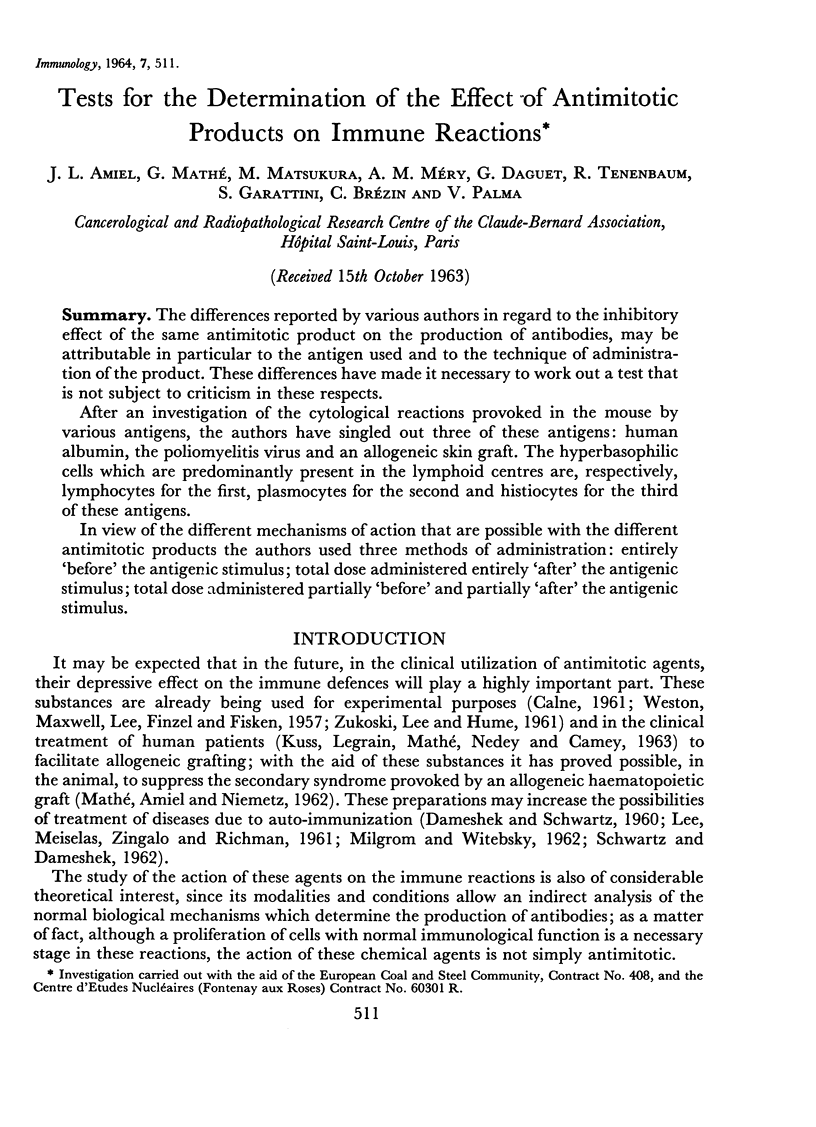
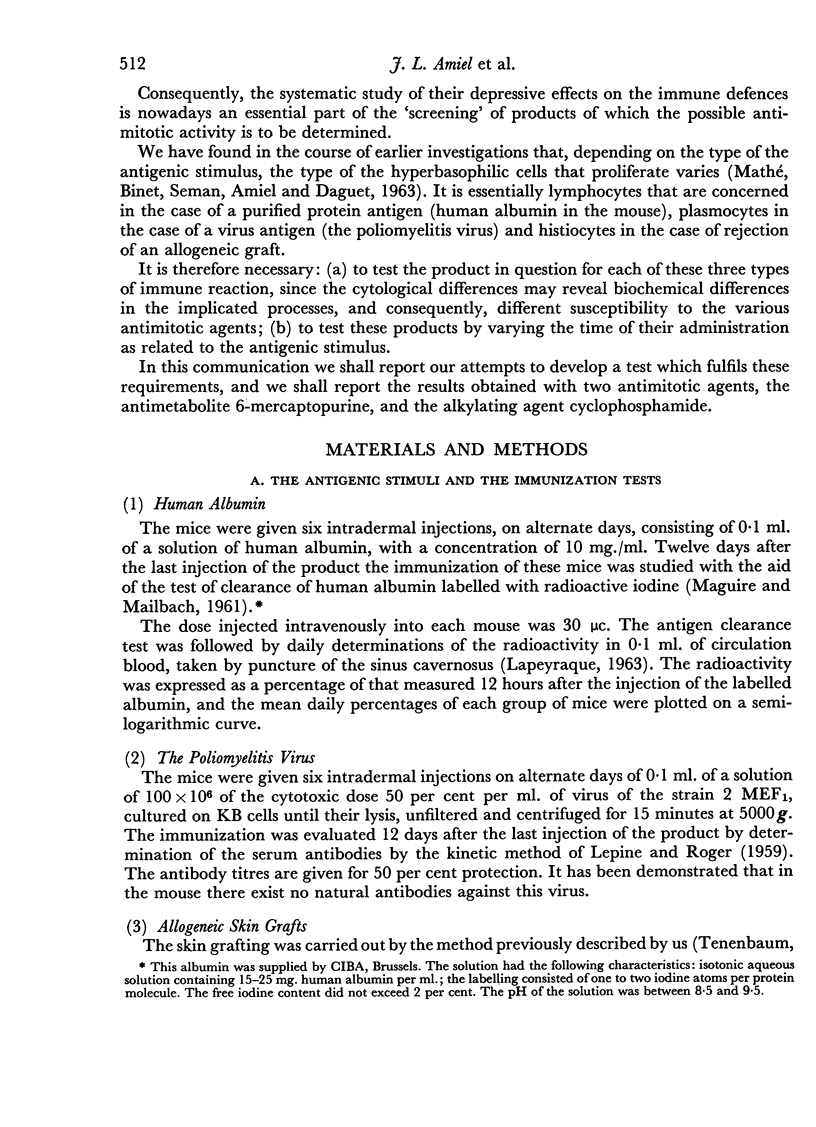
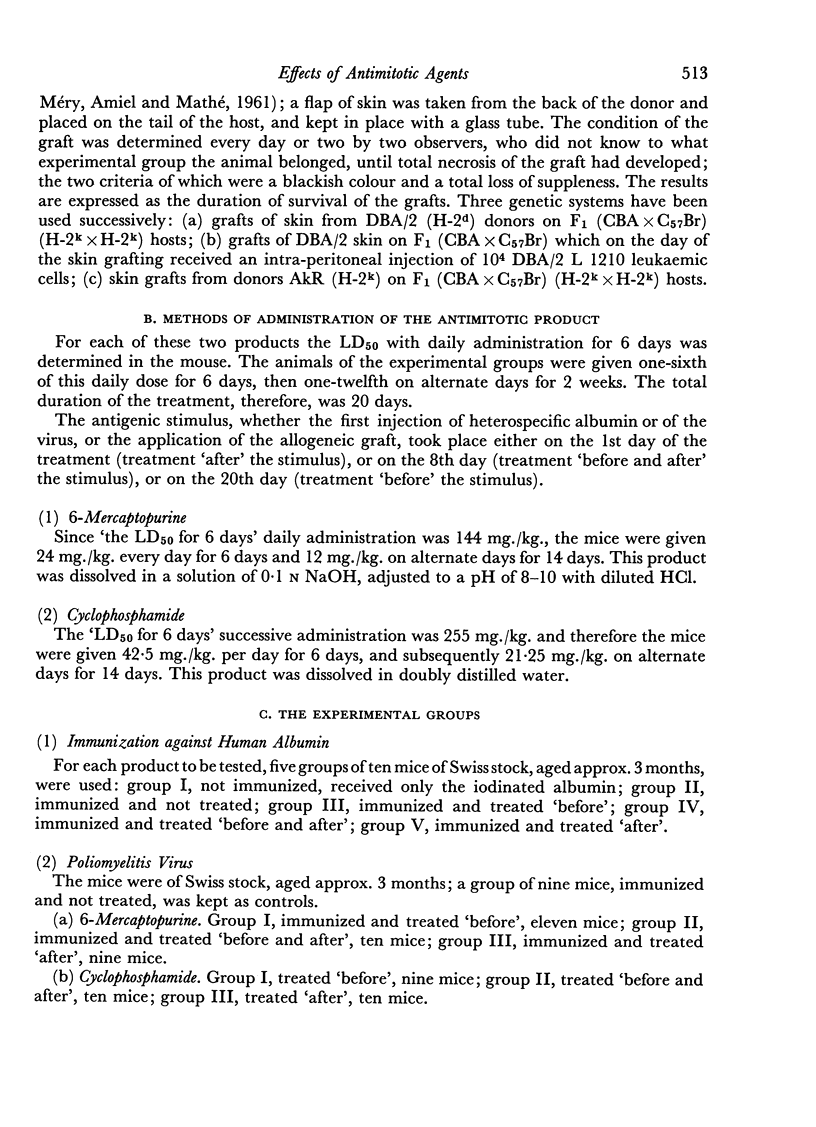
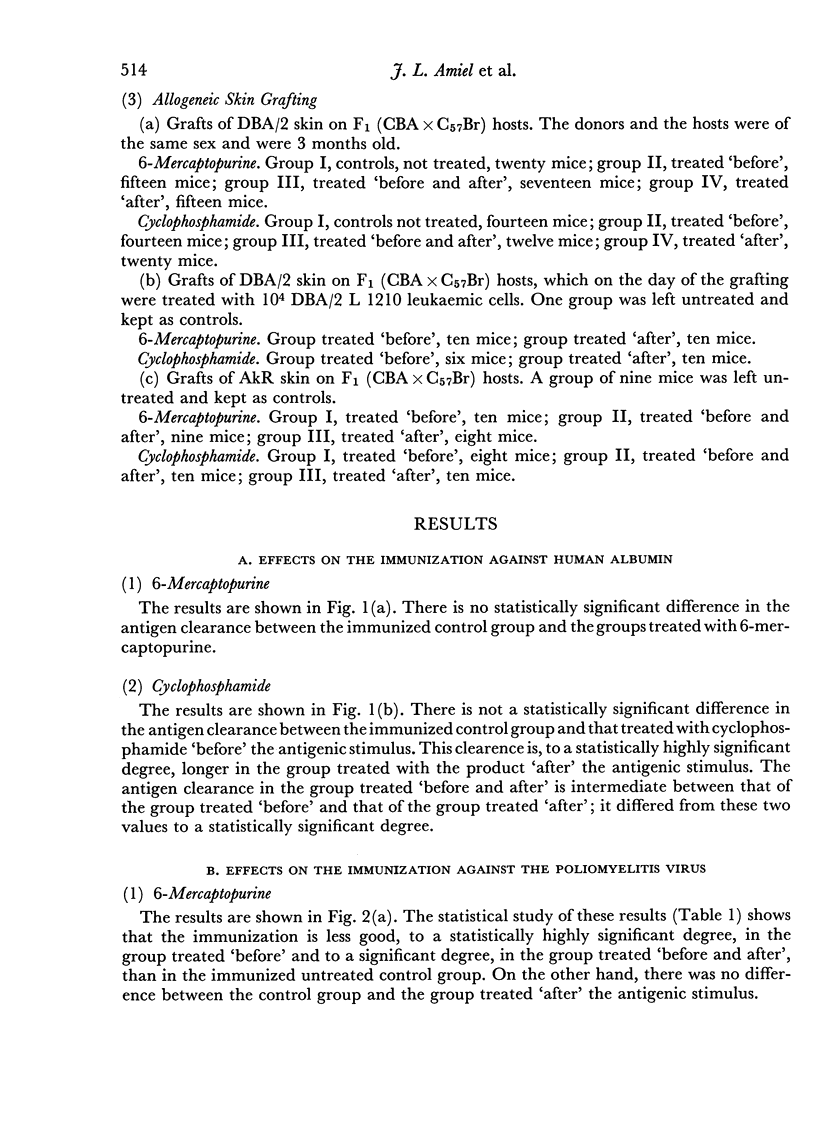
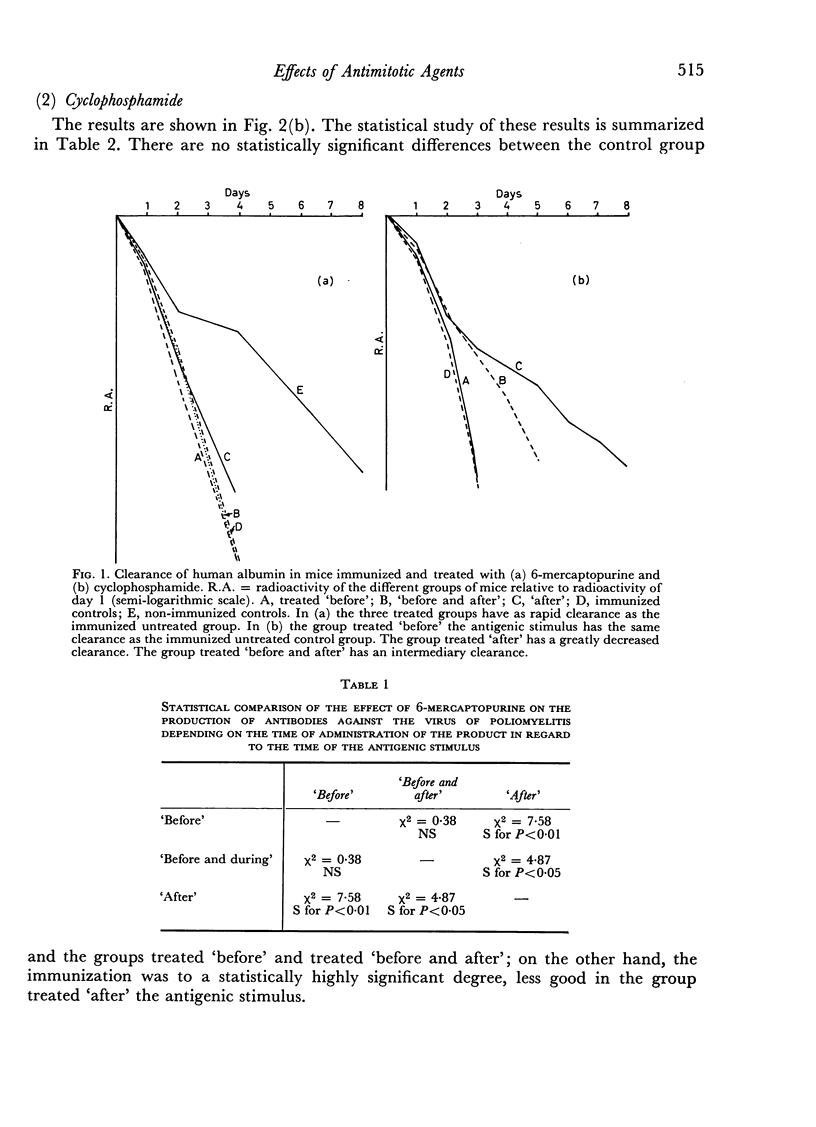
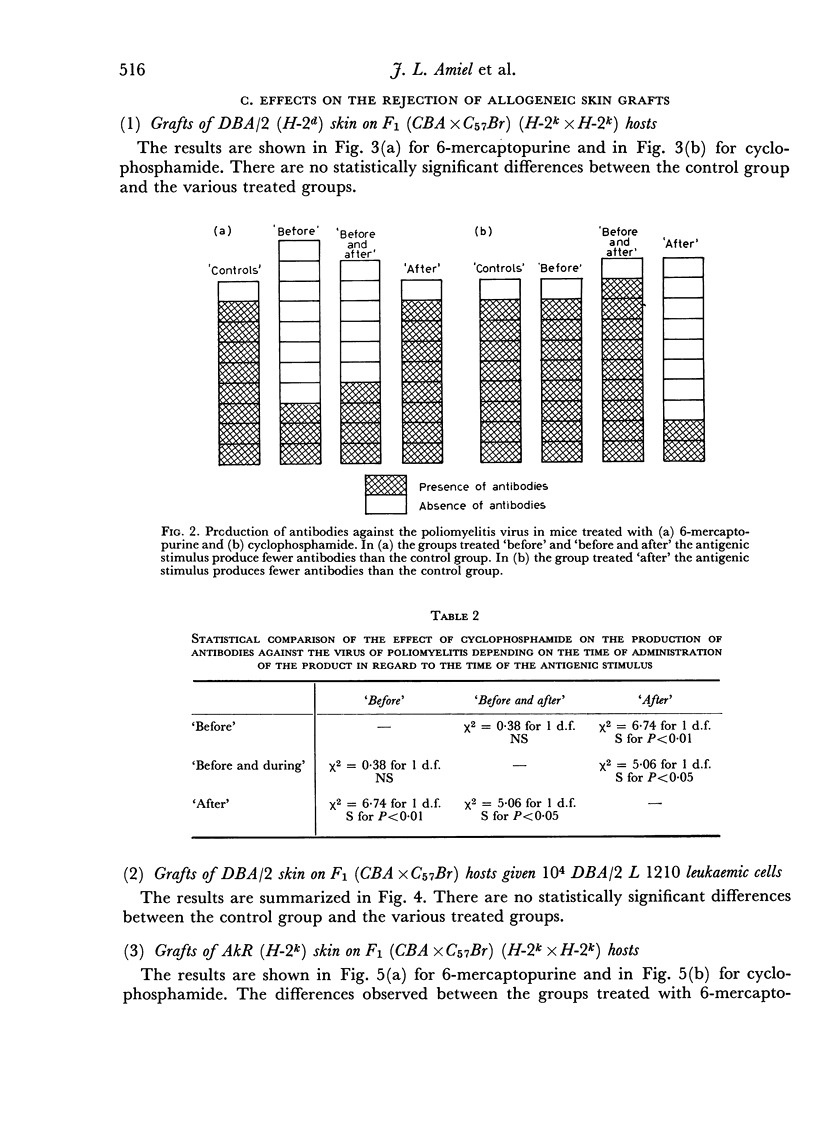
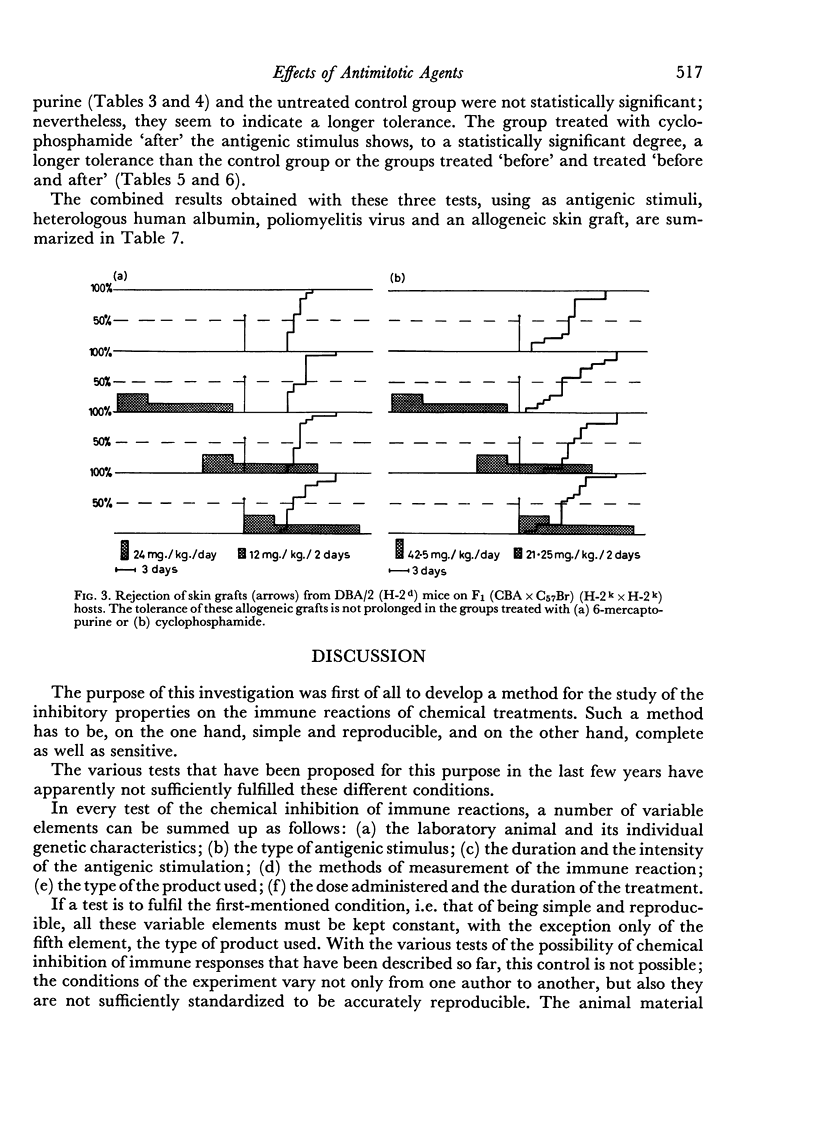
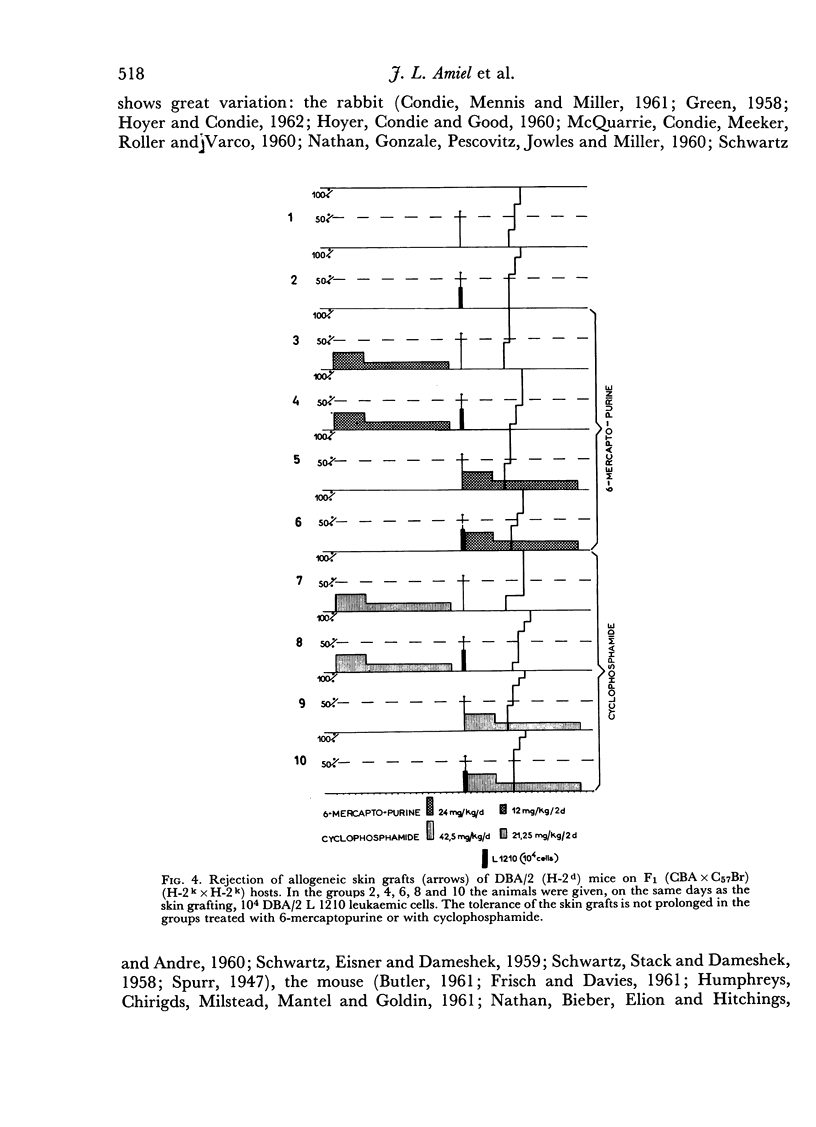
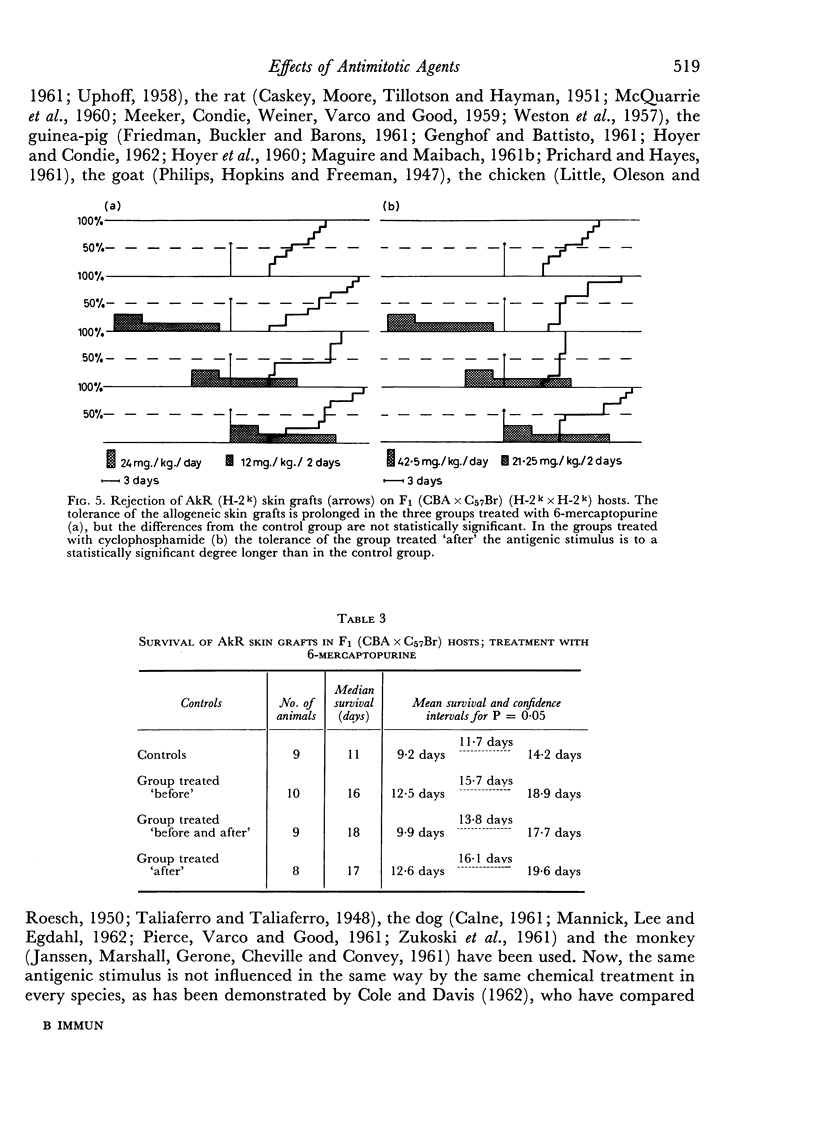
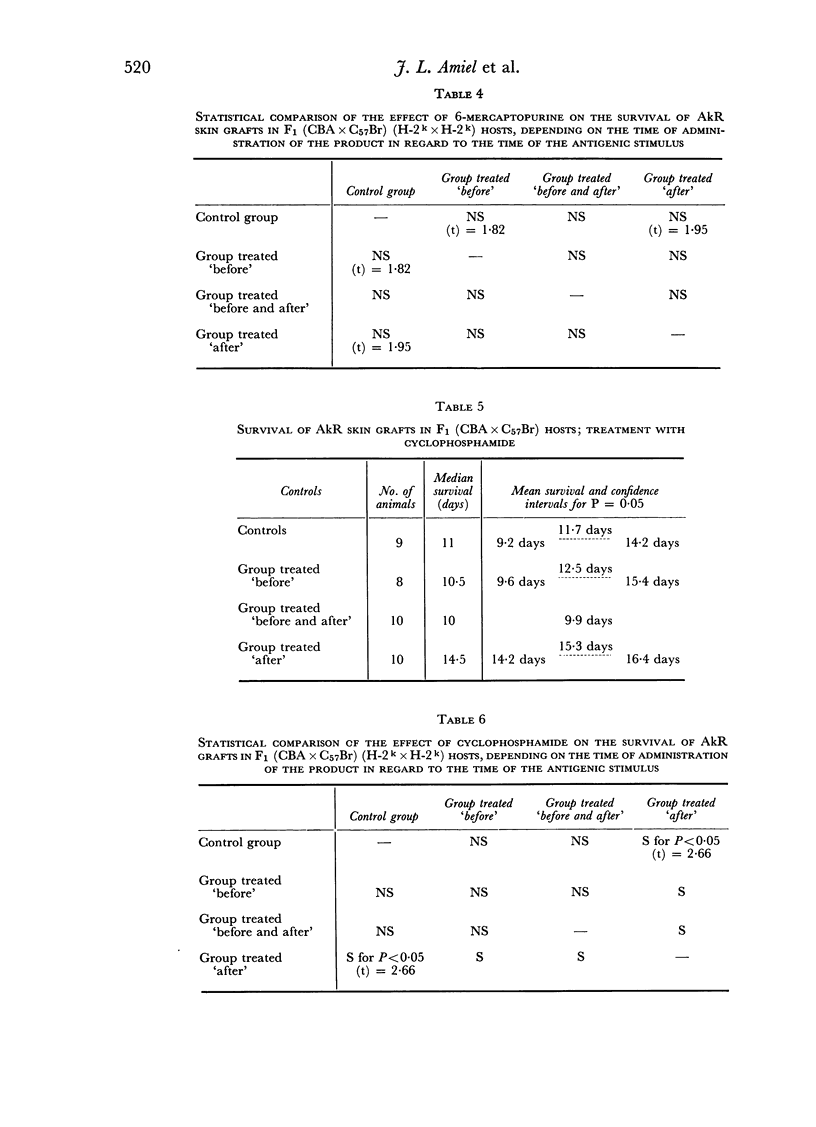
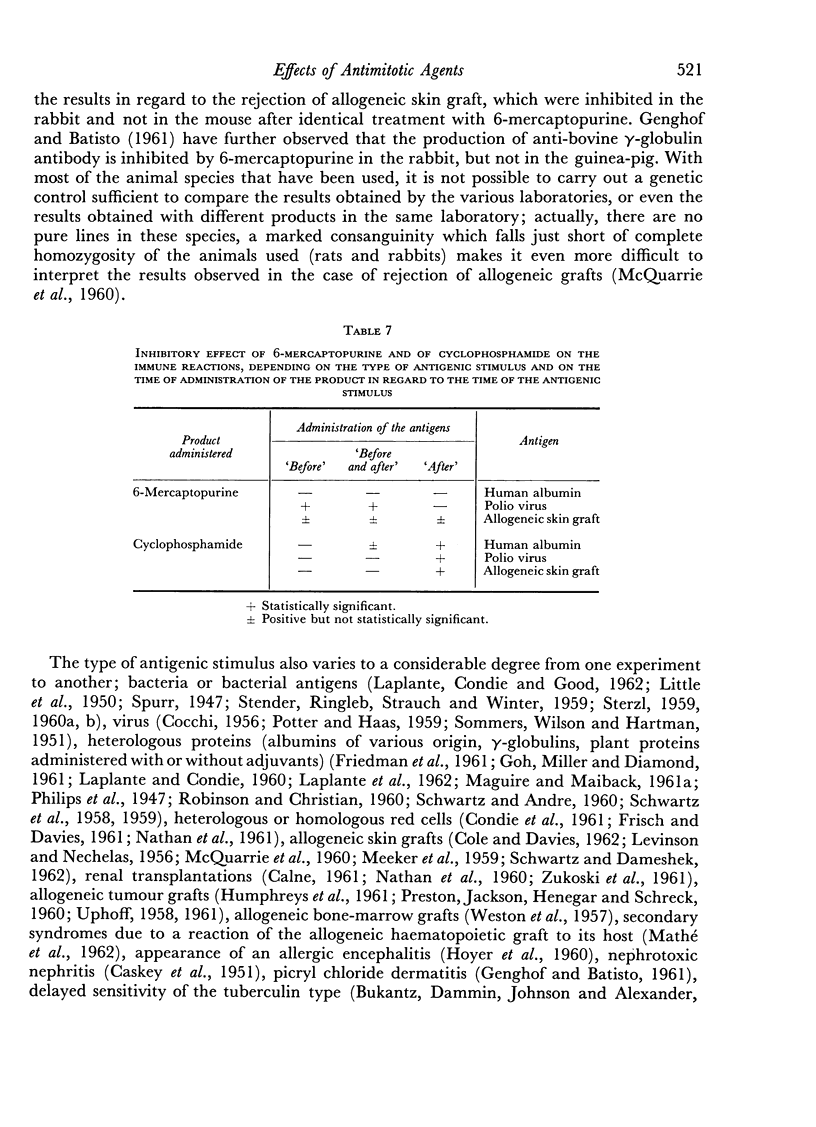
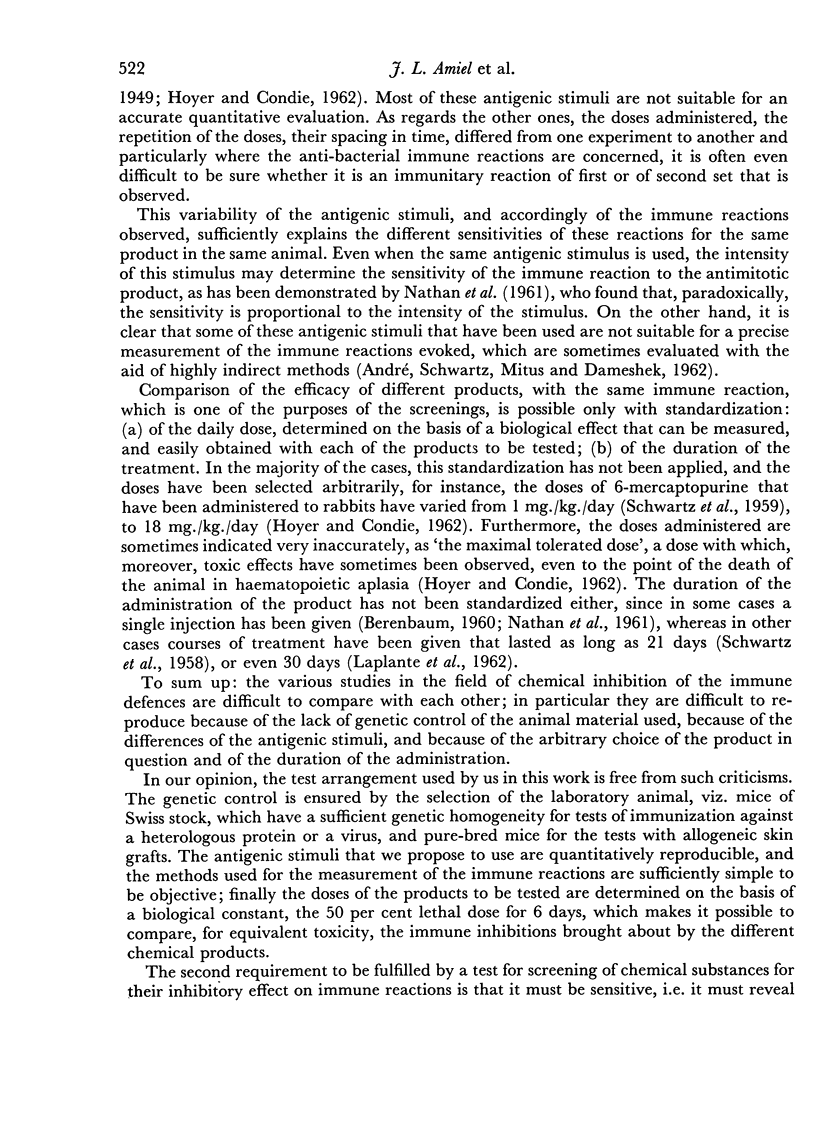
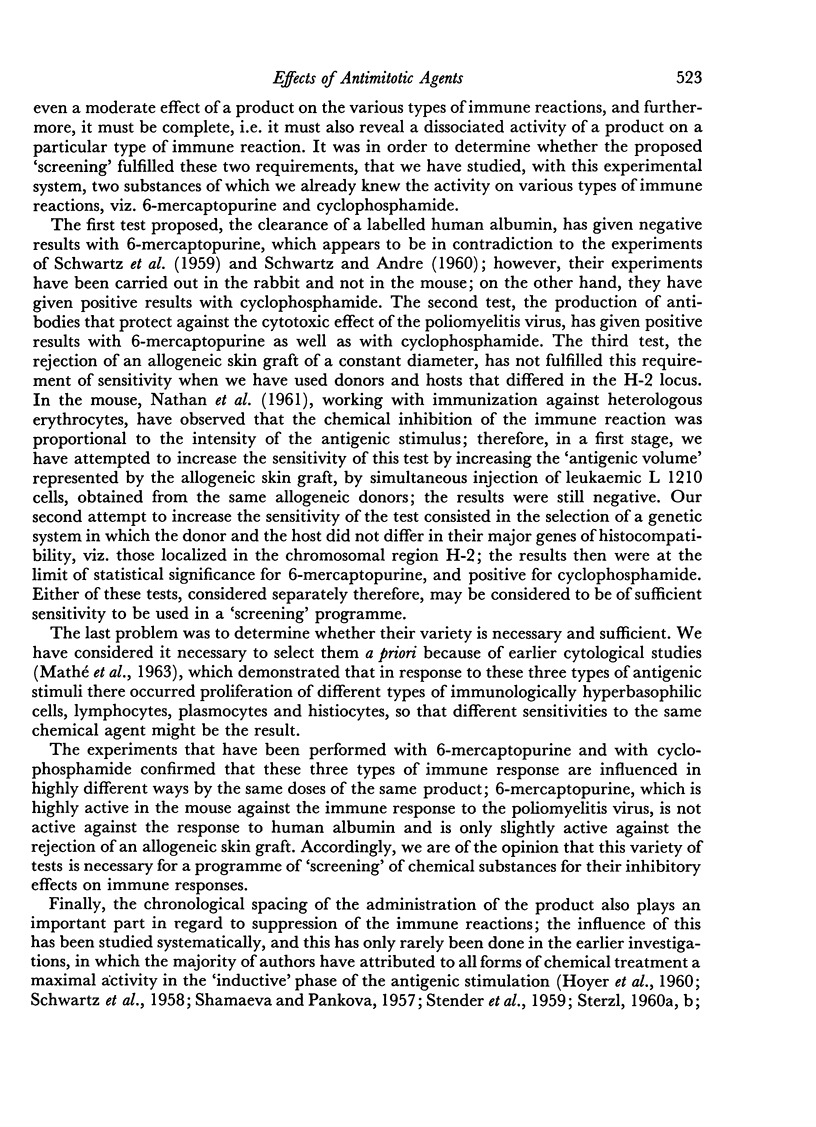
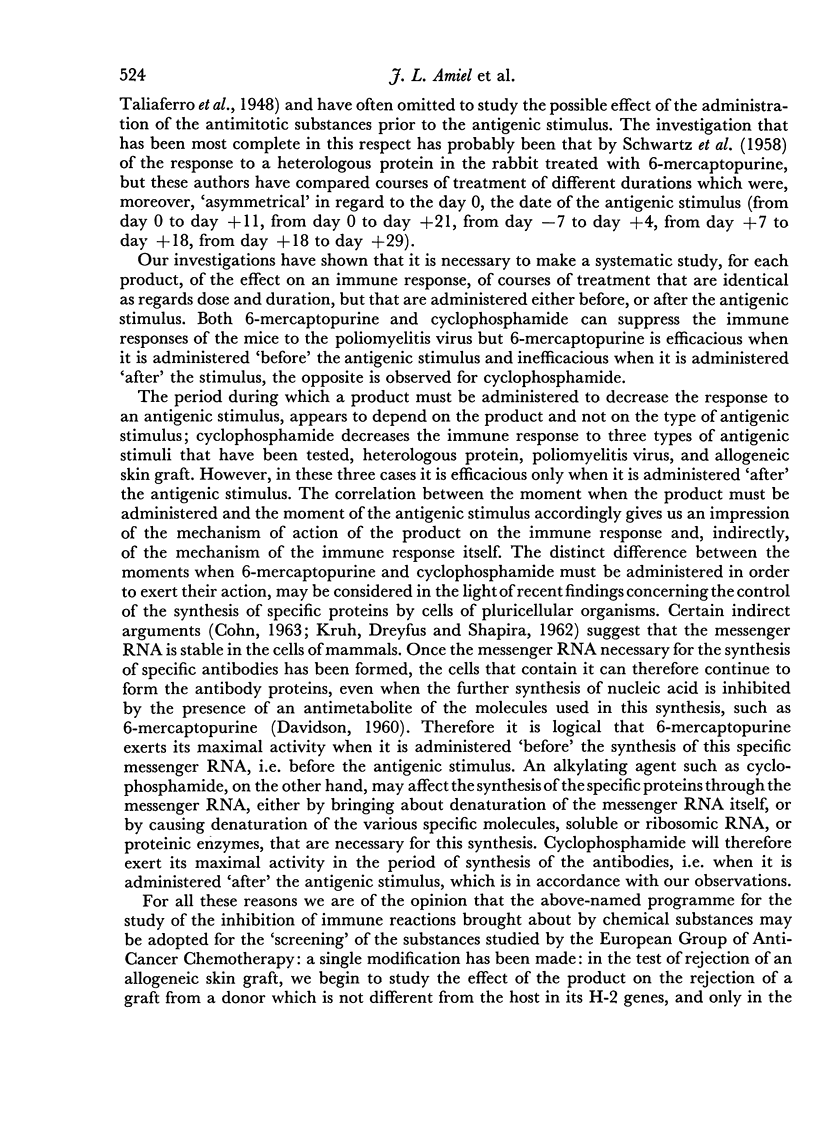
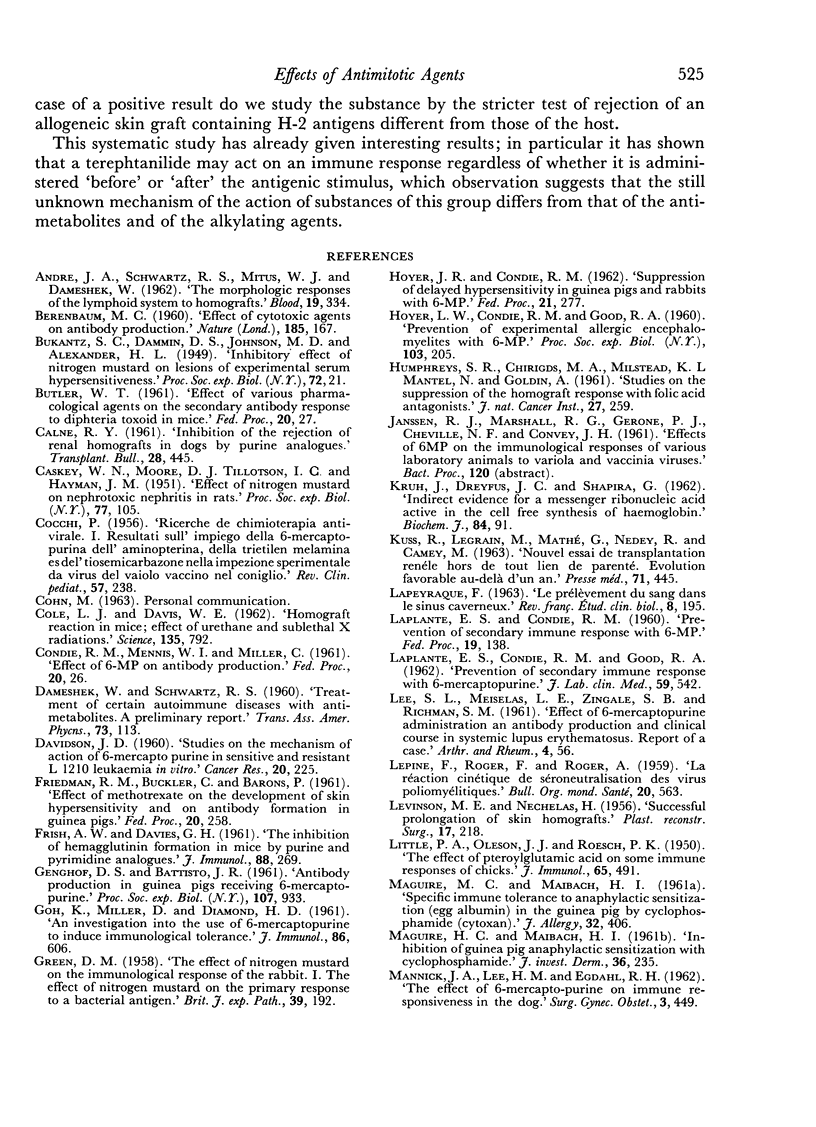

Selected References
These references are in PubMed. This may not be the complete list of references from this article.
- ANDRE J. A., SCHWARTZ R. S., MITUS W. J., DAMESHEK W. The morphologic responses of the lymphoid system to homografts. II. The effects of antimetabolites. Blood. 1962 Mar;19:334–348. [PubMed] [Google Scholar]
- BERENBAUM M. C. Effect of cytotoxic agents on antibody production. Nature. 1960 Jan 16;185:167–168. doi: 10.1038/185167a0. [DOI] [PubMed] [Google Scholar]
- BUKANTZ S. C., DAMMIN G. J. Inhibitory effect of nitrogen mustard (bis beta-chloroethyl amine) on lesions of experimental serum hypersensitiveness. Proc Soc Exp Biol Med. 1949 Oct;72(1):21–26. doi: 10.3181/00379727-72-17319. [DOI] [PubMed] [Google Scholar]
- CASKEY W. H., MOORE D. J., TILLOTSON I. G., HAYMAN J. M., Jr Effect of nitrogen mustard on nephrotoxic nephritis in rats. Proc Soc Exp Biol Med. 1951 May;77(1):105–107. doi: 10.3181/00379727-77-18692. [DOI] [PubMed] [Google Scholar]
- COLE L. J., DAVIS W. E., Jr Homograft reaction in mice: effect of urethane and sublethal x-radiation. Science. 1962 Mar 9;135(3506):792–793. doi: 10.1126/science.135.3506.792. [DOI] [PubMed] [Google Scholar]
- DAMESHEK W., SCHWARTZ R. Treatment of certain "autoimmune" diseases with antimetabolites; a preliminary report. Trans Assoc Am Physicians. 1960;73:113–127. [PubMed] [Google Scholar]
- DAVIDSON J. D. Studies on the mechanism of action of 6-mercaptopurine in sensitive and resistant L1210 leukemia in vitro. Cancer Res. 1960 Feb;20:225–232. [PubMed] [Google Scholar]
- FRISCH A. W., DAVIES G. H. The inhibition of hemagglutinin formation in mice by purine and pyrimidine analogues. J Immunol. 1962 Mar;88:269–273. [PubMed] [Google Scholar]
- GENGHOF D. S., BATTISTO J. R. Antibody production in guinea pigs receiving 6-mercaptopurine. Proc Soc Exp Biol Med. 1961 Aug-Sep;107:933–936. doi: 10.3181/00379727-107-26801. [DOI] [PubMed] [Google Scholar]
- GOH K. O., MILLER D. G., DIAMOND H. D. An investigation into the use of 6-mercaptopurine to induce immunological tolerance. J Immunol. 1961 Jun;86:606–612. [PubMed] [Google Scholar]
- HOYER L. W., CONDIE R. M., GOOD R. A. Prevention of experimental allergic encephalomyelitis with 6-mercaptopurine. Proc Soc Exp Biol Med. 1960 Jan;103:205–207. doi: 10.3181/00379727-103-25460. [DOI] [PubMed] [Google Scholar]
- HUMPHREYS S. R., CHIRIGOS M. A., MILSTEAD K. L., MANTEL N., GOLDIN A. Studies on the suppression of the homograft response with folic acid antagonists. J Natl Cancer Inst. 1961 Aug;27:259–276. [PubMed] [Google Scholar]
- JONES H. B. Estimation of radiation effects at small exposures. Fed Proc. 1961 Jul;20(Suppl 8):26–28. [PubMed] [Google Scholar]
- KUSS R., LEGRAIN M., MATHE G., NEDEY R., CAMEY M. [New attempt at renal transplantation outside of all family ties. Favorable development beyond a year]. Presse Med. 1963 Feb 23;71:445–448. [PubMed] [Google Scholar]
- LAPLANTE E. S., CONDIE R. M., GOOD R. A. Prevention of secondary immune response with 6-mercaptopurine. J Lab Clin Med. 1962 Apr;59:542–549. [PubMed] [Google Scholar]
- LEE S. L., MEISELAS L. E., ZINGALE S. B., RICHMAN S. M. Effect of 6-mercaptopurine adminstration on antibody production and clinical course in systemic lupus erythematosus. Report of a case. Arthritis Rheum. 1961 Feb;4:56–63. doi: 10.1002/art.1780040106. [DOI] [PubMed] [Google Scholar]
- LEPINE P., ROGER F., ROGER A. [The kinetic reaction of sero-neutralization of poliomyelitis virus]. Bull World Health Organ. 1959;20:563–578. [PMC free article] [PubMed] [Google Scholar]
- LEVINSON M. E., NECHELES H. Successful prolongation of survival of skin homografts. Plast Reconstr Surg (1946) 1956 Mar;17(3):218–219. doi: 10.1097/00006534-195603000-00005. [DOI] [PubMed] [Google Scholar]
- LITTLE P. A., OLESON J. J., ROESCH P. K. The effect of pteroylglutamic acid on some immune responses of chicks. J Immunol. 1950 Nov;65(5):491–498. [PubMed] [Google Scholar]
- MAGUIRE H. C., Jr, MAIBACH H. I., MINISCE L. W., Jr Inhibition of guinea pig anaphylactic sensitization with cyclophosphoramide. J Invest Dermatol. 1961 Apr;36:235–236. doi: 10.1038/jid.1961.39. [DOI] [PubMed] [Google Scholar]
- MAGUIRE H. C., Jr, MAIBACH H. I. Specific immune tolerance to anaphylactic sensitization (egg albumin) induced in the guinea pig by cyclophosphoramide (Cytoxan). J Allergy. 1961 Sep-Oct;32:406–408. doi: 10.1016/0021-8707(61)90018-1. [DOI] [PubMed] [Google Scholar]
- MANNICK J. A., LEE H. M., EGDAHL R. H. The effect of 6-mercaptopurine on immune responsiveness of the dog. Surg Gynecol Obstet. 1962 Apr;114:449–457. [PubMed] [Google Scholar]
- MATHE G., AMIEL J. L., NIEMETZ J. [Bone marrow grafts after total irradiation of leukemic mice followed by administration of an antimitotic agent to reduce the incidence of a secondary syndrome and to enhance the antileukemic effect]. C R Hebd Seances Acad Sci. 1962 May 14;254:3603–3605. [PubMed] [Google Scholar]
- MILGROM F., WITEBSKY E. Autoantibodies and autoimmune diseases. JAMA. 1962 Aug 25;181:706–716. [PubMed] [Google Scholar]
- PIERCE J. C., VARCO R. L., GOOD R. A. Prolonged survival of a renal homograft in a dog treated with 6-mercaptopurine. Surgery. 1961 Jul;50:186–195. [PubMed] [Google Scholar]
- PIERCE J. C., VARCO R. L. Induction of tolerance to a canine renal homotransplant with 6-mercaptopurine. Lancet. 1962 Apr 14;1(7233):781–782. doi: 10.1016/s0140-6736(62)91788-9. [DOI] [PubMed] [Google Scholar]
- POTTER M., HAAS V. H. Relationships between lymphocytic choriomeningitis virus, amethopterin, and an amethopterin-resistent lymphocytic neoplasm in mice. J Natl Cancer Inst. 1959 Apr;22(4):801–809. [PubMed] [Google Scholar]
- PRESTON F. W., JACKSON E. J., HENEGAR G. C., SCHREK R. Effects of alkylating drugs and combinations of x-irradiation and cortisone on tumor immunity. Ann Surg. 1960 Oct;152:594–601. doi: 10.1097/00000658-196010000-00004. [DOI] [PMC free article] [PubMed] [Google Scholar]
- PRICHARD R. W., HAYES D. M. The effects of aminopterin on guinea pig tuberculosis. Am J Pathol. 1961 Mar;38:325–333. [PMC free article] [PubMed] [Google Scholar]
- ROBINSON J. L., CHRISTIAN C. L. 6-mercaptopurine in immunological responsiveness. Nature. 1960 Aug 27;187:796–797. doi: 10.1038/187796a0. [DOI] [PubMed] [Google Scholar]
- SALVIN S. B., SMITH R. F. The specificity of allergic reactions. I. Delayed versus Arthus hypersensitivity. J Exp Med. 1960 Apr 1;111:465–483. doi: 10.1084/jem.111.4.465. [DOI] [PMC free article] [PubMed] [Google Scholar]
- SCHWARTZ R. S., ANDRE J. Clearance of proteins from blood of normal and 6-mercaptopurine treated rabbits. Proc Soc Exp Biol Med. 1960 Jun;104:228–230. doi: 10.3181/00379727-104-25788. [DOI] [PubMed] [Google Scholar]
- SCHWARTZ R., DAMESHEK W. The treatment of autoimmune hemolytic anemia with 6-mercaptopurine and thioguanine. Blood. 1962 Apr;19:483–500. [PubMed] [Google Scholar]
- SCHWARTZ R., EISNER A., DAMESHEK W. The effect of 6-mercaptopurine on primary and secondary immune responses. J Clin Invest. 1959 Aug;38(8):1394–1403. doi: 10.1172/JCI103915. [DOI] [PMC free article] [PubMed] [Google Scholar]
- SCHWARTZ R., STACK J., DAMESHEK W. Effect of 6-mercaptopurine on antibody production. Proc Soc Exp Biol Med. 1958 Oct;99(1):164–167. doi: 10.3181/00379727-99-24281. [DOI] [PubMed] [Google Scholar]
- SOMMERS S. C., WILSON J. C., HARTMAN F. W. Lymphoid lesions in poliomyelitis. J Exp Med. 1951 May;93(5):505–512. doi: 10.1084/jem.93.5.505. [DOI] [PMC free article] [PubMed] [Google Scholar]
- STERZL J. Inhibition of the inductive phase of antibody formation by 6-mercaptopurine examined by the transfer of isolated cells. Nature. 1960 Jan 23;185:256–257. doi: 10.1038/185256a0. [DOI] [PubMed] [Google Scholar]
- UPHOFF D. E. Alteration of homograft reaction by A-methopterin in lethally irradiated mice treated with homologous marrow. Proc Soc Exp Biol Med. 1958 Dec;99(3):651–653. doi: 10.3181/00379727-99-24450. [DOI] [PubMed] [Google Scholar]
- WIGZELL H., LINDER O. E. Absence of hybrid-specific histocompatibility antigens in the mouse. Transplant Bull. 1961 Oct;28:110–113. [PubMed] [Google Scholar]


